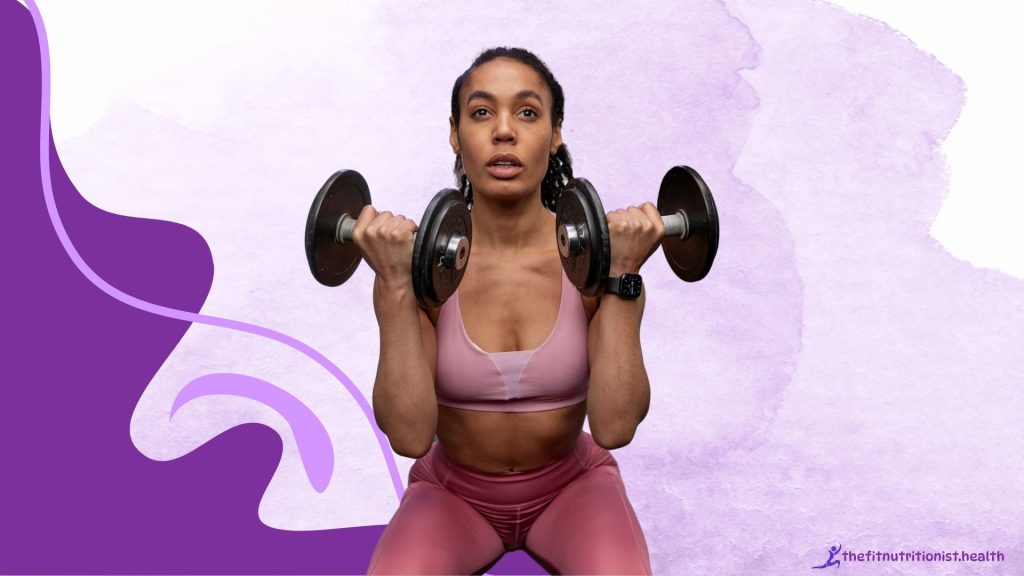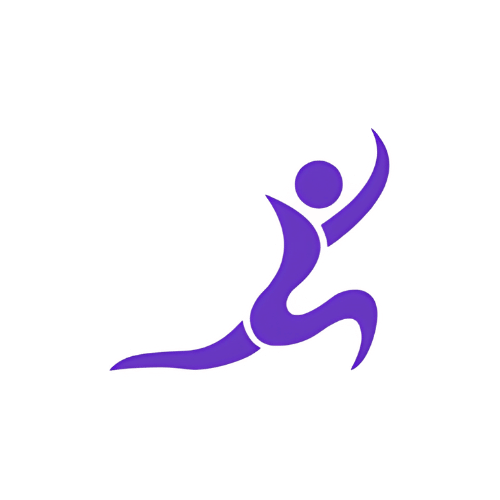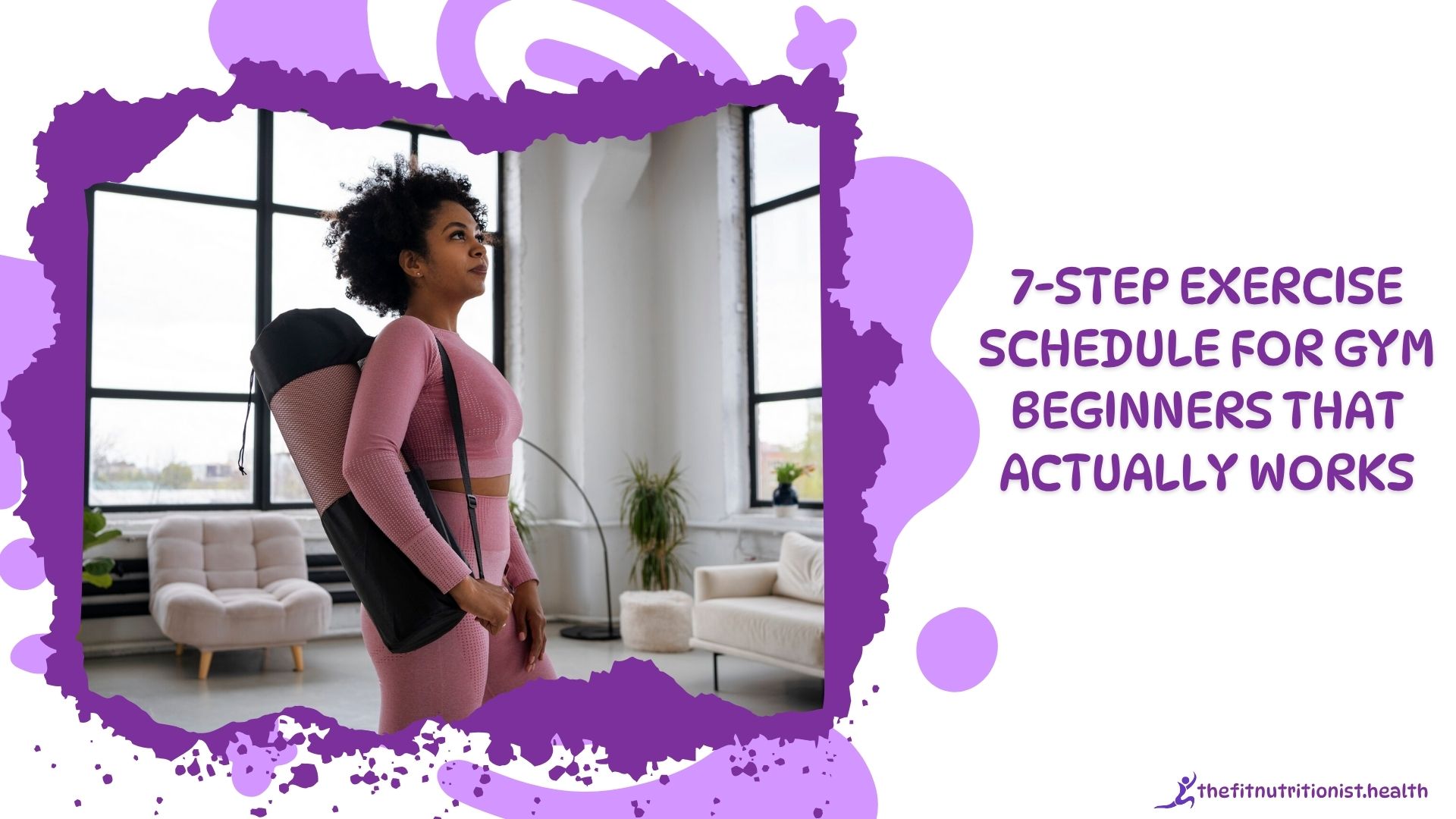Table of Contents
Walking into the gym for the first time can feel like stepping onto another planet. Weird machines, sweaty strangers, and an overwhelming sense of “what now?” But what if you had an exercise schedule for gym beginners? A simple, science-backed exercise schedule that didn’t just get you started but kept you going?
This isn’t about pushing you into 5 HIIT sessions a week or pretending building a healthy body takes 7 days. It’s about creating an exercise schedule for gym beginners that works because it’s built for real life. We’ve sifted through the fluff. Combining insights from expert-backed programs and fitness psychology principles to find something that works.
So, no, you don’t need to “go hard” to get results. You need a thoughtful exercise schedule for gym beginners, tailored to your current body, real life, and long-term goals. That’s what thefitnutritionist delivers. Whether you’re just unzipping your gym bag for the first time or finally getting serious about self-care. We’ll walk you through the steps that work.
Key Insights:
- Most beginners see improved posture and core stability after just 1 week of structured strength exercises.
- Lat pulldowns and dumbbell presses build upper body power while protecting beginners from common shoulder injuries.
- Cardio machines like treadmills and ellipticals help new gym-goers ease into workouts without excessive fatigue.
- Lower-body routines targeting glutes, quads, and calves offer foundational strength that supports overall gym progress.
- Many gym beginners struggle to stay consistent during the first 30 days, often due to burnout and unsustainable routines.
- Scheduling regular recovery days reduces fatigue and helps first-time exercisers avoid injury and overtraining.
- Recovery and sleep are essential in beginner progress. They help muscles repair and boost energy between workouts.
Step 1: Exercise Schedule for Beginners: Understand the Gym Landscape

Before you start lifting, pressing, or pedaling, take time to get your bearings. The first few gym visits are for learning, not lifting heavy. Use them to explore the equipment, ease your nerves, and set the tone for your journey. This foundational phase helps you feel confident before jumping into your exercise schedule for gym beginners.
Learn the Equipment
Your first mission? Learn the lay of the land. Don’t just hop on the nearest machine; watch how others use it. Ask a trainer to show you proper form, especially for machines like the lat pulldown or leg press. This is key to avoiding injury and boosting your confidence early on.
Start with a Dynamic Warm-Up
Never jump straight into your workout cold. A good dynamic warm-up improves blood flow and loosens your joints. Start with a 5-minute brisk walk on the treadmill to activate your lower body. Follow that with leg swings and ankle rotations to prime your muscles. This 5-minute habit helps prevent injury and boosts workout performance immediately.
Know What to Wear
You don’t need fancy gear, but comfort and function matter. Wear breathable, flexible clothing that won’t restrict your range of motion. Supportive gym shoes are essential, especially for lower-body exercises like squats and lunges. Good footwear protects your joints and helps you maintain balance. Remember, gear should serve your body, not impress others.
Hydration Is Non-Negotiable
Hydration plays a vital role in your performance and recovery. Aim to drink 11.5 to 15.5 cups of water daily, as recommended by nutrition experts. Being properly hydrated improves energy levels and reduces fatigue during workouts. Especially in your first week, water helps prevent dizziness and cramping. Keep a bottle with you at all times in the gym.
Pick the Right Time to Train
If you feel anxious in crowds, avoid peak gym hours. Mornings and late evenings tend to be quieter and less intimidating. More space and fewer people help you focus on form without distractions. Lower crowd levels also reduce wait times for equipment.
Step 2: Build a Balanced Weekly Exercise Schedule for Gym Beginners

Now that you’re familiar with your environment, it’s time to add structure. A balanced routine ensures consistent results and prevents overtraining. This is where an exercise schedule for gym beginners becomes sustainable, repeatable, and enjoyable. At thefitnutritionist, we help you achieve results. You can read a client review to see how real beginners are gaining momentum with our approach.
Weekly Breakdown (The 3/2/1 Rule)
This method divides your week into 3 strength days, 2 cardio days, and 1 flexibility or recovery day. It keeps your workouts varied and your body balanced. This approach is beginner-friendly because it gives you space to rest and recharge. Following this method also aligns with recommendations from the American Heart Association. You’ll build endurance, strength, and mobility.
Start with Low Weights, High Reps
High reps with lighter weights help you learn movement patterns safely. This is especially important for exercises like squats and presses. Aim for 12–15 reps per set during your first few sessions. It allows your joints, muscles, and nervous system to adapt. You’ll also minimize soreness and reduce your risk of injury.
Add Variety to Prevent Boredom
Mix in machines, free weights, and bodyweight moves. Try using dumbbells one day, a cable machine the next. Include a group class or guided sessions. Variety keeps the mind engaged and targets muscles differently. The more fun and flexible your schedule, the more likely you’ll stick with it.
Plan Recovery Like a Workout
Rest days are where the magic happens. This is when your muscles rebuild and grow stronger. Without recovery, progress stalls, and injuries increase. Sleep, good nutrition, and mobility work should be part of your exercise schedule for gym beginners. Foam rolling and static stretching on rest days can reduce soreness. Think of recovery as proactive training, not just downtime.
Track Your Progress
Write down what you did, how it felt, and what improved. Keep a simple log of weights, reps, or cardio time. Tracking builds confidence by showing tangible progress. It also helps you troubleshoot plateaus or dips in motivation.
Pop Quiz: Are You Gym-Ready?
Wait, hold up. Before sprinting off to deadlift something heavy… are you set up for gym success? Take our Health Quiz to find out. It’s fun, free, and helps uncover what’s holding you back. It takes less than 3 minutes, and you’ll walk away feeling clearer and more motivated than ever.
Step 3: Exercises to Prioritize in Your First 7 Gym Visits?
Feeling stuck on what to do each day? Many beginners struggle with choosing the right exercises. Having a daily focus sets the tone for your first full week at the gym.
Cardio Day: Getting Comfortable with Movement
Start with 20–25 minutes on a treadmill, elliptical, or stationary bike. These are low-impact and easy to control. Begin at a light intensity, then slowly increase speed or resistance. This builds cardiovascular endurance without overwhelming your body. Cardio sessions help ease you into gym life.
Lower Body Day: Build Your Foundation
Train your legs and glutes using box squats, lunges, glute bridges, and calf raises. These movements strengthen your base and improve overall balance. Focus on controlled, deliberate motion. Start with three sets of 10–20 reps. Strong legs support nearly every other movement in your routine.
Upper Body Day
Lat pulldowns, dumbbell chest presses, and high planks target essential upper body muscles. These moves improve posture and upper-body coordination. Use light to moderate weights to begin, with 3 rounds per exercise. Prioritize proper form over heavy loads. With each session, you’ll build strength and confidence.
Core & Stability
Your core supports everything from squats to shoulder presses. Focus on planks, bird dogs, and other stability moves. These exercises reduce back pain and improve your gym performance. They also teach you how to engage your midsection correctly. Start with short holds and progress slowly.
Mobility & Stretch
Don’t skip flexibility work; your joints and muscles will thank you. Foam rolling and static stretches help prevent soreness and improve range of motion. Add this on the rest days or post-workout. Yoga and simple mobility drills can keep you moving well long-term. It’s the secret weapon to staying injury-free.
Exercise Schedule for Gym Beginners: Pro Tips
- Use the Couch to Gym Method: Start with three 30-minute sessions per week. Build from there.
- Don’t Ignore Warm-Ups: Dynamic warm-ups prevent injury and boost performance. 5 minutes is all it takes to make your workout better.
- Use Guided Programs: Many gyms offer beginner-friendly tours or coaching programs. Use them. They exist to help you succeed.
- Set Micro-Goals: Want to do 10 full squats? Or 3 pull-ups? Track your progress toward small wins, not just the scale.
- Listen to Your Mood: If you’re dragging mentally, do something light. Mental fatigue is real, and the fix might be rest, not reps.
Step 4: Gym Routine That Prevents Burnout in the First 30 Days
The first month at the gym determines if your new habit sticks or slips away. Burnout is one of the biggest reasons beginners quit. This step helps you avoid that crash by designing an exercise schedule for gym beginners that you look forward to. It blends variety, rest, and motivation for the long haul.
Use an Exercise Schedule for Gym Beginners to Avoid Burnout
Start with no more than 5 days a week, and never work the same muscle group back-to-back. Alternate between strength, cardio, and recovery days to stay fresh. This phased structure prevents overuse and improves long-term adherence. Consistency is the goal, not intensity.
Set Smart, Not Extreme Goals
Ditch the “six-pack in six days” mindset. Instead, focus on showing up 3 times a week for the first month. Goals like “complete four strength workouts” or “increase weight by 5 lbs” keep expectations realistic. Smart goals in an exercise schedule for gym beginners help you build confidence and keep you moving forward. They also lower frustration from slow progress.
Celebrate Small Wins
Every extra rep or extra 5 minutes on the treadmill is progress. Recognize these achievements as markers of consistency. Celebrating even small milestones boosts motivation and reduces gym fatigue. It also rewires your brain to seek progress, not perfection. This mindset keeps your journey sustainable.
Step 5: Get the Ideal Weekly Balance of Strength and Cardio
Beginners often overcommit to one training style and neglect the other. Too much strength can lead to stiffness; too much cardio can lead to muscle loss.
Strength vs Cardio for Beginners
Aim for 2 to 3 strength sessions each week paired with 2 cardio sessions. This combination develops lean muscle and boosts cardiovascular health. It also prevents boredom, which increases the chance of sticking with your routine. Alternating days gives your body time to recover while continuing progress. This structure supports both strength gains and fat loss.
Keep Workouts Short but Effective
30 to 45 minutes is all you need per session. Focus on circuits, supersets, or interval formats to keep things efficient. Avoid marathon sessions that leave you exhausted or sore for days. Shorter workouts are easier to commit to and easier to recover from.
Watch for Recovery Cues
Soreness that lasts more than 72 hours may signal overtraining. If you feel tired all day or struggle to focus, you might need extra rest. Listen to your body before adding more volume. These cues help you adjust, not quit. Rest is as productive as reps.
Step 6: Track Muscle Engagement and Fatigue During the First Few Weeks
Tracking your progress helps you grow smarter, not just stronger. Read your body’s signals and measure success with data, not just the mirror. It’s a powerful way to stay motivated and avoid injury in your early gym days. A good exercise schedule for gym beginners will help you keep track of this.
Use the RPE Scale
The Rate of Perceived Exertion (RPE) helps you gauge effort on a 1–10 scale. In the beginning, stay at around 6–7 for strength work and 5–6 for cardio. If you’re hitting 9 or 10 often, dial it back. This simple scale protects you from burnout while encouraging effort. Learning to regulate intensity is key to long-term gains.
Wearables Help
Tools like heart rate monitors and fitness watches help monitor effort. They show trends in sleep, recovery, and output. Seeing patterns builds self-awareness and gives you hard data to guide future workouts. You’ll know when to push and when to rest. Tech adds accountability to your effort.
Use the Mirror and Mind-Muscle Connection
Watch your form during exercises, especially compound movements. If you’re doing glute bridges but only feel your lower back, something’s off. Adjust the technique or reduce the weight until the right muscle activates. Feeling the muscle work is more important than moving heavier loads. The mirror helps correct posture, too.
Keep a Workout Journal
Write down your exercises, reps, and how you felt after each session. Track soreness, sleep, and motivation levels. Patterns will emerge that help you adjust your exercise schedule for gym beginners. This journal becomes a personal progress log and a confidence builder.
Don’t Ignore Pain
Soreness is normal. Sharp, sudden pain is not. If you experience discomfort beyond 48–72 hours, step back and reassess. Listening to your body early helps prevent long-term damage. Pain is a signal, not a challenge.
Step 7: Expect Realistic Physical and Mental Results
The first week of your exercise schedule for gym beginners might not produce a visual change. However, a lot is already happening. You’ll feel different before you look different. This step prepares your mind for real progress and helps you focus on what matters most: health, not hype.
Exercise Schedule for Gym Beginners: Before and After Results
You may not see visible muscle, but you’ll feel improvements in mood, energy, and sleep quality. Posture might improve as your body starts to stabilize. Within the first week, you’ll begin walking taller and breathing easier. These are meaningful changes that set the tone for real transformation.
Mental Health Benefits of an Exercise Schedule for Gym Beginners
Exercise releases endorphins, dopamine, and serotonin. All chemicals that are linked to improved mood and reduced anxiety. Just 1 week of movement with an exercise schedule for gym beginners can help stabilize emotions. You’ll notice better focus and lower stress levels by week 2. The mental shift is one of the most rewarding benefits early on.
Don’t Compare
Your journey is yours alone. Comparing yourself to influencers or long-time gym-goers sabotages progress. Focus on your consistency, not others’ aesthetics. Personalized fitness builds lasting results, not short-term pressure.
Ready to burn fat and build muscle? This beginner plan shows you exactly how.
FAQs
What workout routine should I do as a beginner? Start with full-body workouts 3 times a week. Combine cardio and strength, keep it simple and repeatable with your exercise schedule for gym beginners.
What is the 3/2/1 rule in gym? 3 strength sessions, 2 cardio days, 1 recovery day. It’s balanced, beginner-friendly, and sustainable.
What is the 70/30 rule in the gym? This means 70% nutrition, 30% training. You can’t out-train a bad diet. Fuel your fitness properly.
What is the 5×5 rule in the gym? It’s a strength program: 5 sets of 5 reps using compound lifts. Great for building foundational strength over time.
What to eat before the gym? A mix of carbs and protein. Think banana and peanut butter or oats and Greek yogurt. Avoid high-fat, heavy meals.
How many bananas before a workout? One is enough. It gives quick energy from carbs and potassium to prevent cramping. Eat it 30–60 minutes before.
Get an Exercise Schedule for Gym Beginners that Works
By now, you understand that fitness isn’t about following a generic “7-day challenge” you found online. It’s about building a relationship with your body. This isn’t about chasing a physique that looks like someone else’s. It’s about becoming stronger in the body you live in today. An effective exercise schedule for gym beginners isn’t a boot camp, it’s a roadmap. With insight from Thefitnutritionist, you’ll stop second-guessing yourself and build a fitness plan that’s as unique as you are. Get a custom health plan designed around your body, life, and goals. You’ve shown up. Now let’s make it count.

